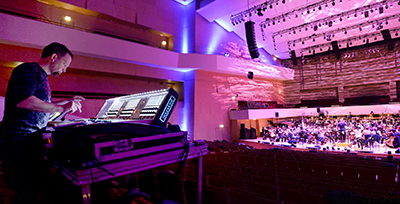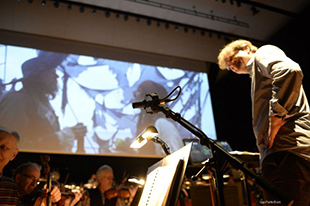![]() Claiming to be the first orchestra to ‘go fully digital’, the Lille National Orchestra (ONL) is using a digital signal chain from sound pick-up to recording.
Claiming to be the first orchestra to ‘go fully digital’, the Lille National Orchestra (ONL) is using a digital signal chain from sound pick-up to recording.
The orchestra’s own mobile studio comprises a total of 33 digital Neumann microphones, 24 digital Sennheiser microphones (all on active stands and booms), and six DMI-8 interfaces. Also included in the studio are a six-channel Sennheiser wireless system and a full Neumann monitoring set-up.
‘For us, the fully digital mobile studio is like a new instrument in the orchestra,’ says Managing Director François Bou. ‘It allows completely new aesthetics in our work. ‘We are playing classical music but this does not mean that we are an orchestra of yesteryear. Deeply rooted in both classical and contemporary music, the ONL is a high-tech orchestra that adapds to its audiences in specific environments and in the media.

‘Our mobile studio will be a great asset in both recordings,’ he adds. ‘There will be broadcasts on the France 3 regional channel, and also live streams of ONL concerts on digital platforms – this will increase the presence and reputation of the orchestra still further, and take their music to new audiences.’
The orchestra’s home is Le Nouveau Siècle in Lille, a venue that was fully renovated and re-opened in 2013 and boasts a residual noise floor of 20dB(A) only. The place is famed for its acoustics, and is a haven of creativity and creation. It therefore comes as little surprise that the venue is often rented to other ensembles and orchestras – and its attractiveness will further increase with the new mixing and recording possibilities.
‘Since we have the digital mics, we have had ensembles coming out of the Nouveau Siècle saying how thrilled they were and that they had never heard themselves in such a way,’ says ONL Technical Manager, Stéphane Evrard.
‘You really forget that there are microphones in between you and the orchestra,’ says Frédéric Blanc-Garin, who works as a freelance sound engineer in Stéphane Evrard’s team. ‘If I am asked to compare analogue with digital microphones I would say that using an analogue microphone is very much like using a magnifying glass. The instrument you look at gets bigger but at the edges, the image is slightly blurred, slightly out of focus. Digital microphones, on the other hand, take the whole audience closer to the orchestra.’
Besides recording, the studio equipment is used for amplified or partly amplified concerts such as the orchestra’s ‘cine-concerts’ and outdoor concerts: ‘At the mixing desk, a composer can immediately try out how the music will sound, try its spatiality, even record a tape and see how individual elements should ideally be recreated,’ says Bou. ‘With the digital microphones – and our digital Neumann monitoring loudspeakers – the source is completely pure and unadulterated, and our musicians use the recorded sound to evaluate, control and perfect their playing. The studio has become an important tool in rehearsing, too.’
 The monitoring set-up comprises five Neumann KH 310 D three-way, full-range loudspeakers and a KH 810 studio subwoofer.
The monitoring set-up comprises five Neumann KH 310 D three-way, full-range loudspeakers and a KH 810 studio subwoofer.
‘For each task, we have the right mic set-up at hand,’ explains Blanc-Garin. ‘For any large event – for example the 40th anniversary outdoor concert planned in Lille’s Grand Stade Pierre Mauroy stadium in July 2015 – we will make use of our full complement of digital microphones. If we work with a French radio station, we have a much smaller set-up with their favourite mics in place. If none of these mixes apply, then there’s the basic mix we do for our system for the hearing impaired, with an efficient stereo pair set-up.
‘We even have our own Sennheiser wireless microphone system, a 2000 Series system, which we mainly use for producing our educational material. When we are miking solo vocalists, we rent a Sennheiser Digital 9000 system to ensure the utmost in sound quality.’
The strings are picked up by four Sennheiser MKH 8090 wide cardioids, digitised by the attached MZD 8000 converters, and by four Neumann KMD 143 wide cardioids, which are also used for the bass section of the orchestra (again four models). The woodwinds are covered by a total of five cardioid MKH 8040 stereo matched pairs. The brass is miked by four Neumann D-01 double-diaphragm mics and a Neumann KM 185 D stereo set (hyper-cardioid), while the horns are picked up by two MKH 8090. The percussion section boasts two Neumann KM 185 D stereo sets, four Neumann KMD 143 and a Sennheiser MKH 8020 stereo set (omni). The harp is picked up by a Neumann KMD 145 (cardioid), the celesta by two Sennheiser MKH 8090s. Soloists will be picked up by two MKH 8090s, and an MKH 8040 stereo set, while choirs are miked by three large-diaphragm TLM 103 D (cardioid). Further Neumann mics in use are two KMD 131s (omni), a KM 184 D (cardioid), and a KMD 120 (figure-of-eight).
‘The digital studio is a powerful tool for the orchestra, which also opens up new and powerful means of distribution,’ Bou says. ‘The sound is just amazing in its purity and directness, and workflow-wise, we can keep everything in the digital realm, from instrument pick-up to mastering.’
More: www.sennheiser.com






